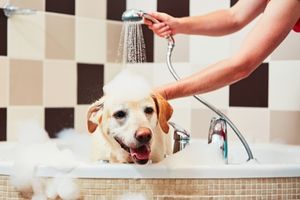It's happened countless times to every owner of a shedding dog. You vacuum and dust your entire house, only to see dog hair accumulating on your freshly-swept floors, vacuumed furniture, and dusted surfaces five minutes later. It's a never-ending cycle that comes with dog ownership, and the reality is you have to learn how to live with it. This is especially true when you glance over at them, happily snoozing away, and you remember how much joy they bring to your life.
Depending on your dog's breed, you might be vacuuming and sweeping daily on a year-round basis or blessed with a seasonally-shedding dog that gives you a break for a few months. Golden Retriever owners, for example, are up against a daily, year-round challenge to rid their home of dog hair, while poodle owners are fortunate to only deal with light shedding in the spring and fall. Following are some tips for coping with constant shedding and keeping your sanity.

Brush Your Dog Often—With the Right Brush
Consistent brushing with the right brush can help alleviate shedding, which loosens the dead hair and collects it instead of landing on your floors and surfaces.
To brush dogs with shorter coats:
- Purchase a bristle brush, hound mitt with palm bristles, or a rubber curry comb
- Brush your dog's hair coat in the opposite direction of growth to help pull dead hair out
- Brush in the direction of hair growth to remove the hair you just loosened
- Repeat this process several times over their entire body
To brush dogs with long or curly coats:
- Purchase a slicker or wire-pin dog brush with longer bristles to tackle both their undercoat and hard outer coat
- Brush your dog's hair coat in both directions several times until you notice less hair accumulating in the brush, cleaning it out multiple times so you can accurately assess progress
- During heavier shedding seasons, use a coat rake or shedding tool and pull in the direction of hair growth before pulling it away from the dog's coat
The American Kennel Club details the various dog brushes and rakes and when to use each.

Re-evaluate Your Dog's Diet to Help With Shedding
Dogs fed a well-balanced diet will automatically consume the vitamins and minerals needed to maintain strong, healthy hair follicles that resist breakage and falling out. Supplements such as Omega-3 fatty acids also promote strong, healthy hair growth. Speak with your veterinarian about your dog's current diet and if Omega-3 supplements are an option. In addition, increasing your dog's water intake can help alleviate shedding. Dehydrated skin is a significant contributor to shedding, so ensure your dog drinks at least one ounce of water per pound of body weight to maintain healthy, hydrated skin. Hill's Pet Nutrition offers insight on dehydration in dogs and how to keep them well-hydrated.

Add More Baths to Your Dog's Hygiene Regimen
Frequent bathing helps remove dead hair, which translates to less hair on your floors and furniture. De-shedding shampoos and conditioners contain moisturizers and Omega-3 fatty acids that help to hydrate your dog's skin and build stronger follicles while also detangling and releasing dead hair from their coat. Since you should also brush your dog after every bath, this double combination of bathing and brushing is a surefire way to reduce shedding.
If your dog has a lot of matting, it might be best to take them to a professional groomer. Groomers have many special tools and, of course, a lot of training to make your dog look and feel their best. Dogs whose hair grows continuously (Poodles, Malteses, Shih Tzus) require regular haircuts.
Since your game plan to reduce shedding will require more bathing and brushing, consider it additional bonding time and have fun with your dog during this time so they look forward to it. Reward your dog for accommodating the multiple brushing sessions with a game of fetch, a long walk, or an extra treat. To learn more about managing your dog's shedding, contact your veterinarian. Don't have one yet? We can help you find a trusted local veterinarian.
